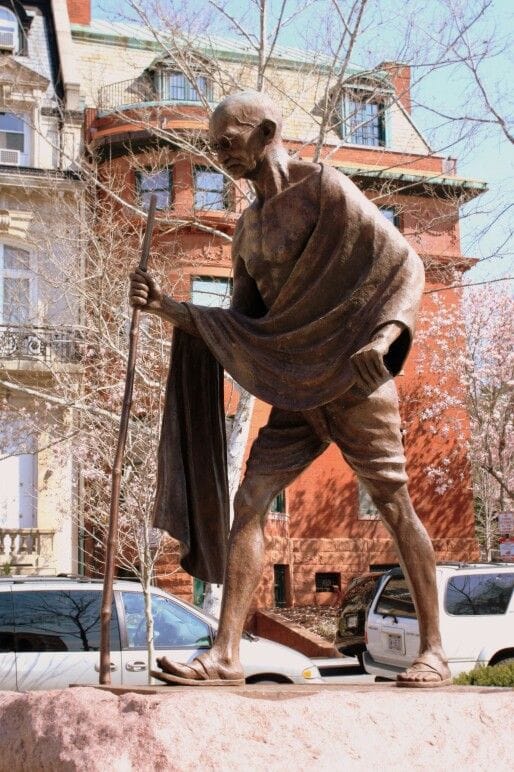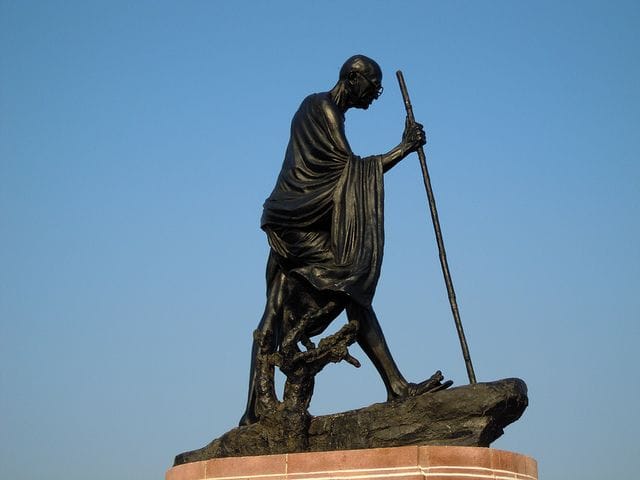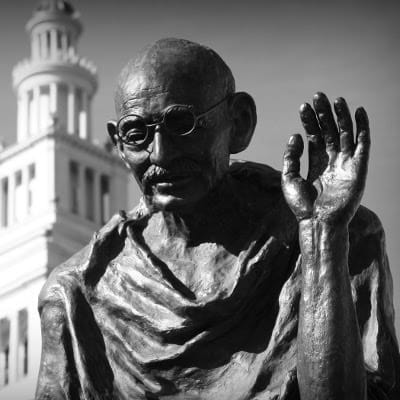The Extraordinary Tale of an Icon: Gandhi Never Visited the US, Yet It Houses the Maximum Number of His Statues: Why?
Mahatma Gandhi was a father of India’s independence and a global icon of non-violence. Yet during his lifetime, he never came to the United States. Still, the United States houses the maximum number of statues dedicated to him outside India. What is more paradoxical is that how a man who never stepped his foot on the United States could imprint himself so roughly on the culture of that land without even leaving one single physical landmark. Herein lies the reason why Gandhi is etched into the American psyche and why his statues are silhouettes of peace, justice, and international harmony.

Why Gandhi Remains Relevant to the American Psyche.
Gandhi, working thousands of miles away but sending powerful messages worldwide about non-violence (Ahimsa) and civil disobedience. He didn’t propose a complex theory: change could be peaceful. Such thought would find its footing in America, at least at this point in a nation’s life, grappling over what it stood for-the system that was supposed to make all equal while it practiced segregation.
However, nothing exemplifies this influence better than the United States of America. Martin Luther King Jr was one of America’s leaders in the civil rights movement, and many times repeated how Gandhi was an inspiration for him. He went to India in 1959 in search of the principles of non-violence practiced by Gandhi, used the same doctrine to address the African American battles for freedom in the U.S. Gandhi’s doctrine of nonviolent resistance gives a moral perspective upon which American leaders and activists developed war against injustice without bloodshed.
Why the U.S. Loves Gandhi’s Legacy

Well, why does America celebrate Gandhi who never set foot on the land? It is because the values they teach resonate with the very fundamental American ideals of democracy, freedom and civil rights. His message-pacifist resistance to oppression-thus had a call to an essentially free people. Since he was born to free India from British colonial domination, his message seemed not circumscribed by nationality.
side by side, Indian-Americans have come to lead the United States in memorializing and celebrating Gandhi. For decades, Indian emigrees, and their children, constructed tens of thousands of cultural centers, schools and community centers that broadcast the message of Gandhi philosophy. They have also been among the most enthusiastic voices demanding the construction of statues in cities throughout the country.
Symbols of Peace and Unity with Statues
Beyond being mere monuments, these are symbols and the Gandhi statues in the U.S. stand for much more than photography likeness. They epitomize the values which he propagated such as peace, non-violence, tolerance, and a quest for justice. And most of these statues sit at places that are of great importance as well. For example, in Washington D.C., one proudly sits right next to the Indian Embassy which exemplifies friendship between India and the United States.
For example, there is a Gandhi statue at Union Square in New York City. A place like that cannot be coincidental: for years, Union Square has been a gathering place for political activism and social justice movements, so he is an important man who dedicated his life to fighting against injustice.
Cultural Diplomacy
The proliferation of the Gandhi statues across the United States also becomes a way of cultural diplomacy. Often, these statues have been welcomed as a gift from the government of India or Indian-American organizations to many American cities. They reflect close and growing ties between the two nations, articulating shared democratic values and commitment to world peace.
As such, it also brings out that the existence of Gandhi’s statues messages that India possesses soft power globally. Be it the politically or economically sensitive relationship, the cultural relationship through such imaginations stays on the topmost position to establish friendly international relationships with other countries. It is through such monuments that Indians message of peace and Gandhi’s philosophy inspire the future generations.
Impact of Gandhi on Social Movements of the United States of America
No leader’s impact is as evident in American social movements as Gandhi’s. His philosophy of nonviolence directly influenced the civil rights movement and continues to influence these new battles for justice. That Martin Luther King Jr could appropriate the Gandhian principles for the Montgomery bus boycott and for other key moments in the civil rights movement gives testimony to how conveniently his methods applied to another context.
True, much of the movement of the 1960sÑsit-ins, marches, and civil disobedienceÑwas in keeping with Gandhi’s own doctrine regarding how one ought to engage in resistance to oppression. What one sees in the world today is the continued aftermath of Gandhi in modern-day social movements: Black Lives Matter and climate change activism, where peaceful protest is still a central strategy for action.
End
As if human existence does not exist in this world, violence and war has captured man’s life. In such a situation, Gandhi’s message could not have been more relevant. His statues in the U.S remind people that peaceful resistance is possible and very effective. Social movements all over the globe, struggling for justice, equality, and environmental sustainability, the teaching of Gandhi explains how not to endorse change through violence.
Moreover, the controversy over monuments within itself in the United States has become the contemporary hot issue, especially with the need of the country to clearly define its history and to whom it plans to pay tribute. In a scenario where some statues are there to stay and others are up for demolition, Gandhi statues would form uncontroversial icons of peace and moral authority.
Beyond Gandhi: Symbols of Statues

A statue of any world leader, for example, Gandhi, might be stunning because it stands for much more than what any individual has done-they represent global ideals for peace and justice and the non-involvement of violence-promises that go beyond all national confines and speak to common humanity by a species.
When the United States puts up Gandhi statues in public places, it pays respect to the ideals and a real desire to protect them in the minds of the masses.
In that sense, the objection over Gandhi’s statues is more so on the symbol he embodies in global consciousness than the man.
Conclusion.
In doing so, the United States honors his legacy for peace, justice, and non-violence in the world. Now, such monuments symbolize unity reminding society that the fight for justice is not through violence but a goal of truth, tolerance, and peaceful resistance. Thus, as far as his role within the United States is concerned, I can say only that he remains the last and, in a true sense, the last excellent legacy for America: inspiring generations towards a better, even more just world.
